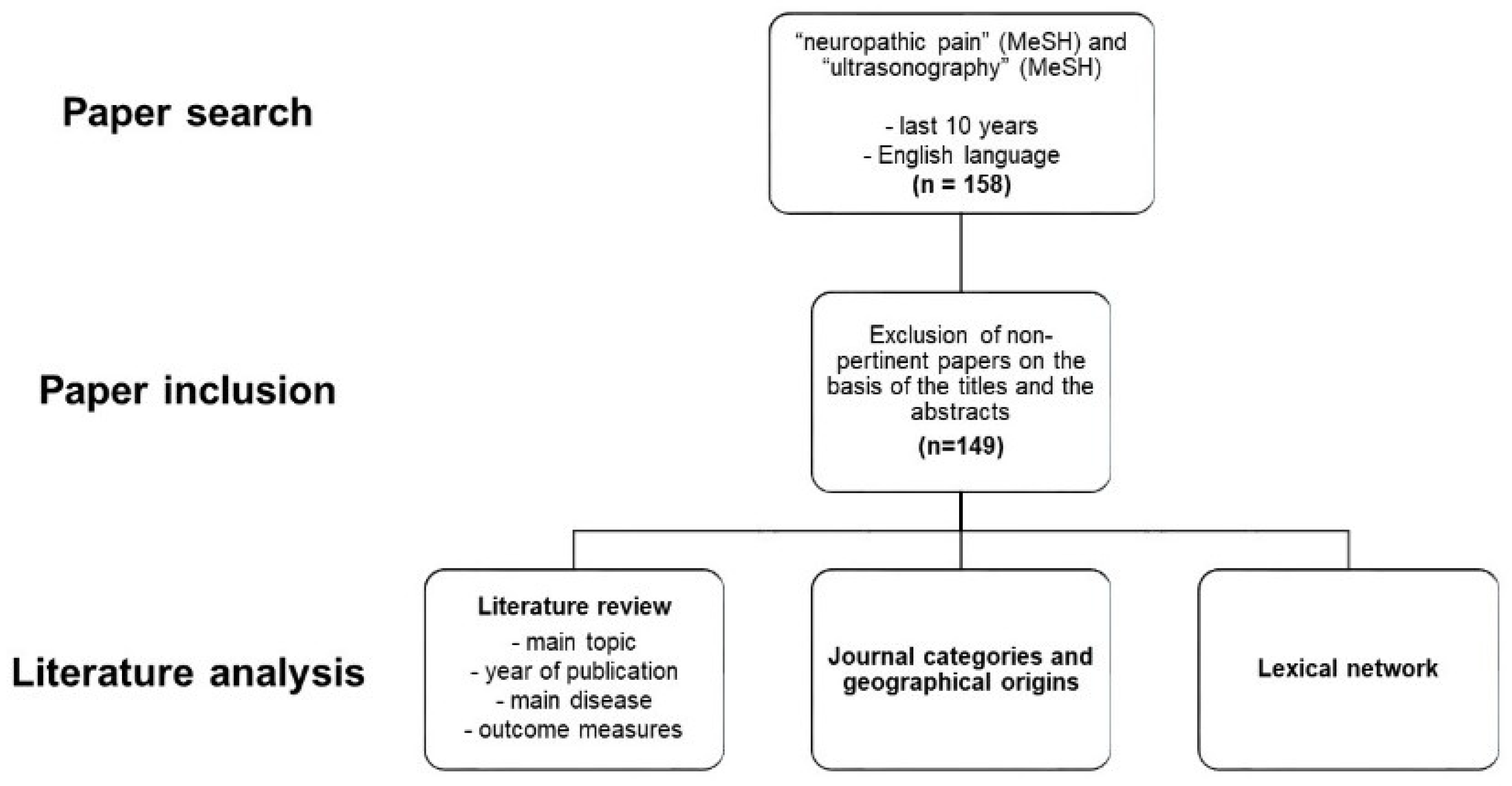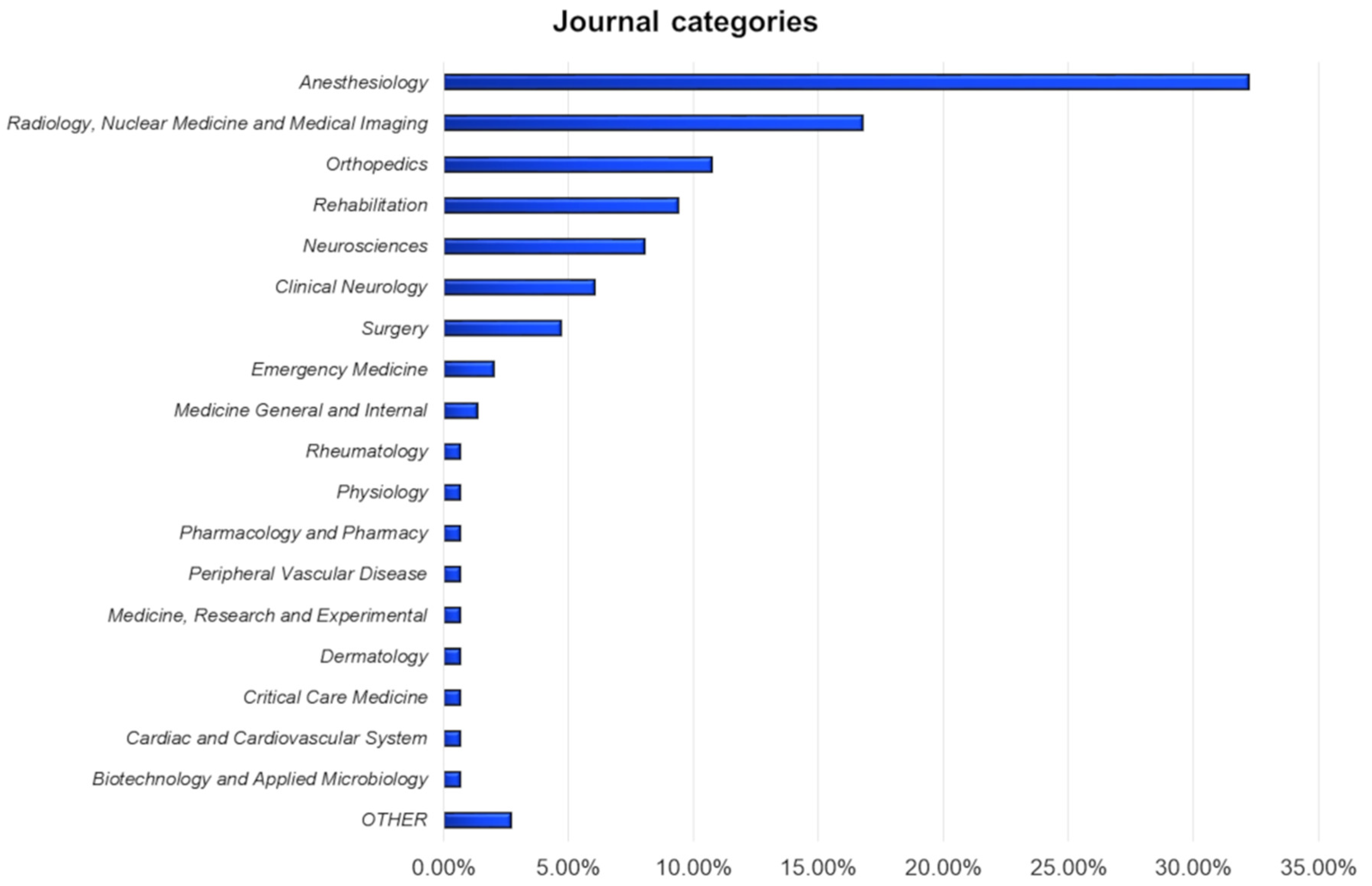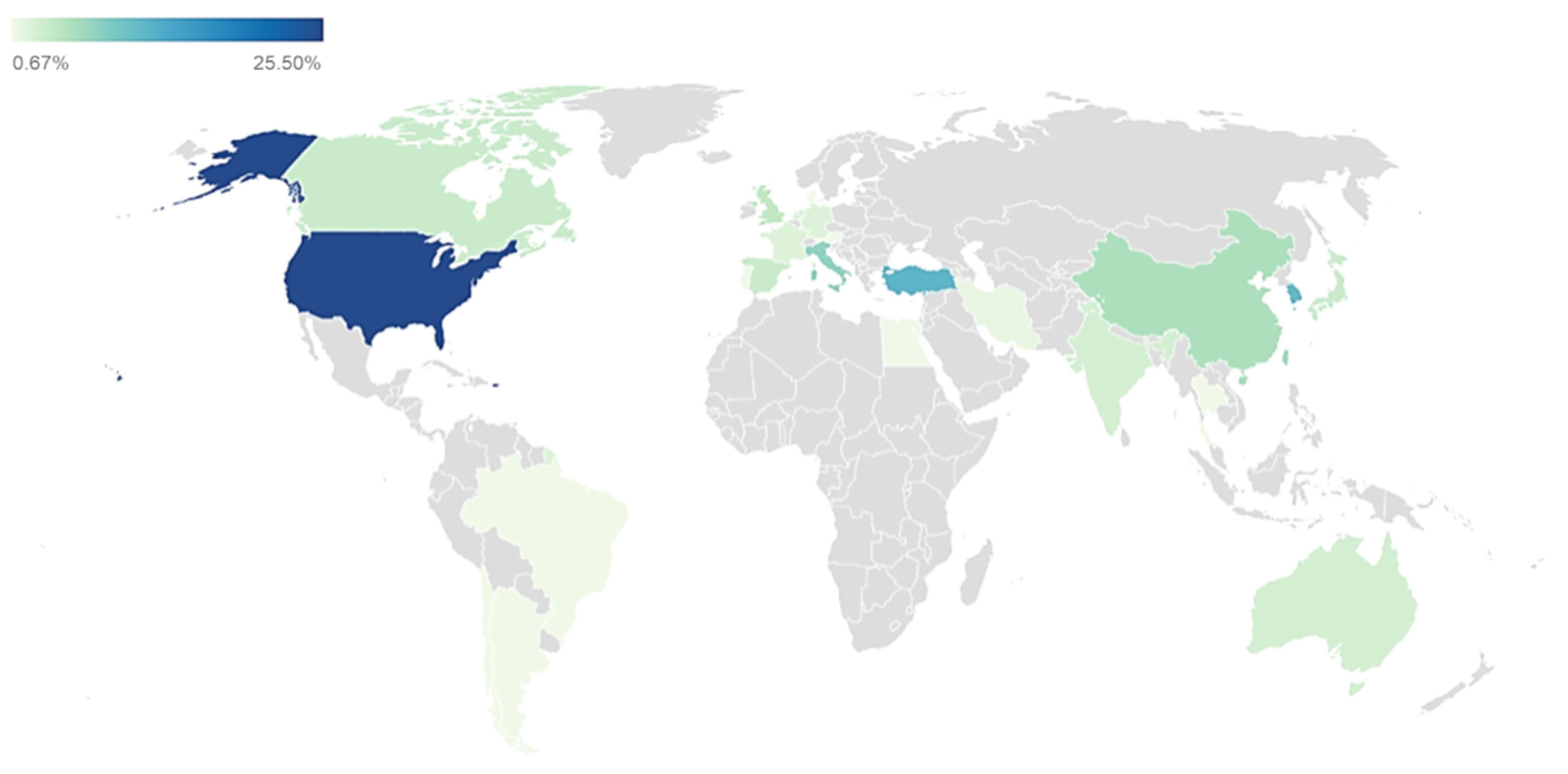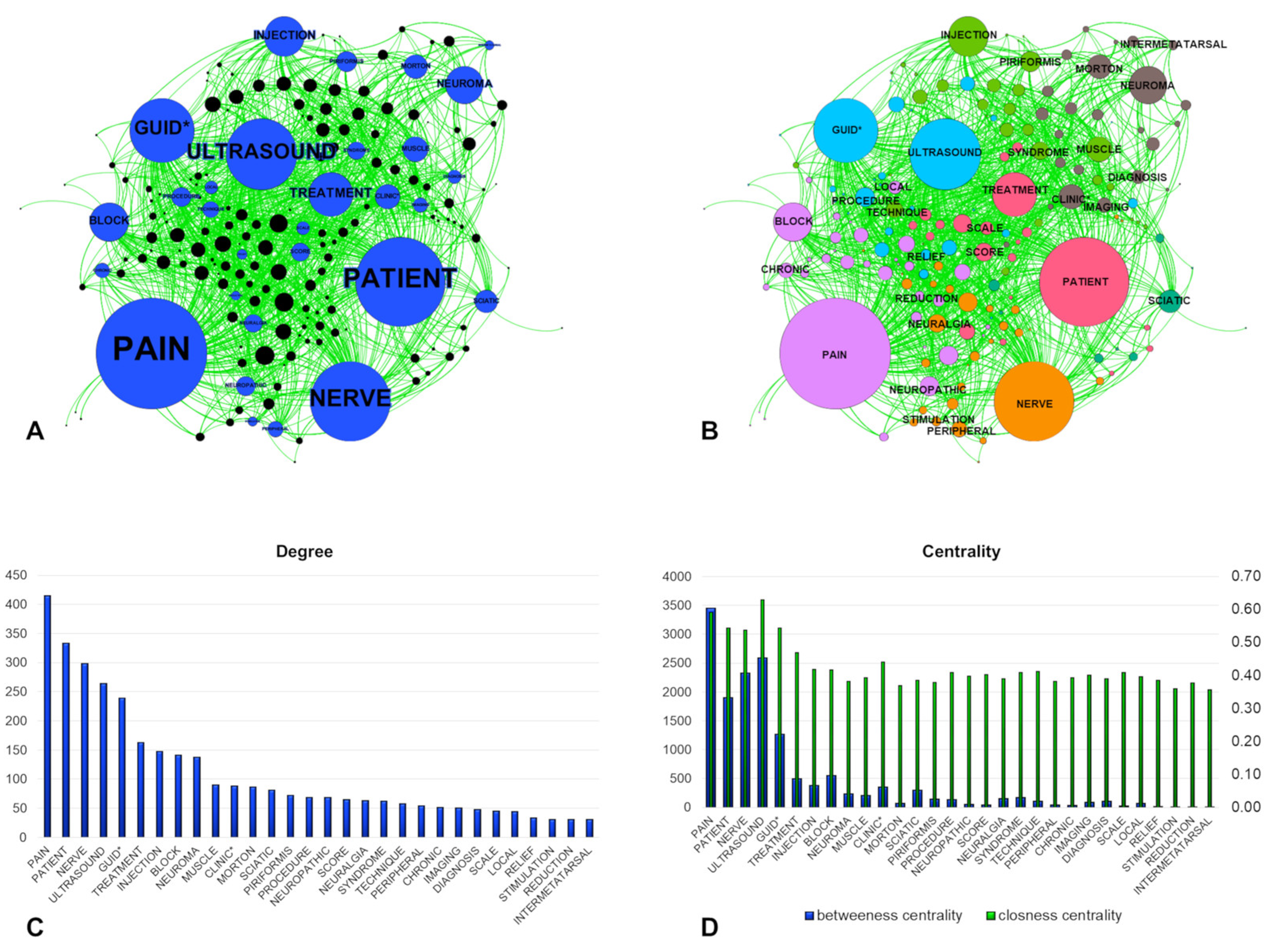Neuropathic Pain and Ultrasonography: A Multiperspective Literature Evaluation
Abstract
:1. Introduction
2. Materials and Methods
2.1. Literature Review
2.2. Journal Categories and Geographical Origins
2.3. Lexical Network Based on Graph-Theory
3. Results
3.1. Literature Review
3.2. Journal Categories and Geographical Origins
3.3. Lexical Network Based on Graph-Theory
4. Discussion
5. Conclusions
Author Contributions
Funding
Institutional Review Board Statement
Informed Consent Statement
Data Availability Statement
Conflicts of Interest
References
- Smith, B.H.; Hébert, H.L.; Veluchamy, A. Neuropathic pain in the community: Prevalence, impact, and risk factors. Pain 2020, 161 (Suppl. 1), S127–S137. [Google Scholar] [CrossRef] [PubMed]
- Coraci, D.; Loreti, C.; Glorioso, D.; Giovannini, S.; Padua, L. The impact of diagnostic ultrasound in clinical medicine and in nerve evaluation: PubMed and Google Ngram Viewer compared. Neurophysiol. Clin. 2020, 50, 305–307. [Google Scholar] [CrossRef]
- Baron, R.; Binder, A.; Wasner, G. Neuropathic pain: Diagnosis, pathophysiological mechanisms, and treatment. Lancet Neurol. 2010, 9, 807–819. [Google Scholar] [CrossRef]
- Bouhassira, D. Neuropathic pain: Definition, assessment and epidemiology. Rev. Neurol. 2019, 175, 16–25. [Google Scholar] [CrossRef]
- Giovannini, S.; Coraci, D.; Brau, F.; Galluzzo, V.; Loreti, C.; Caliandro, P.; Padua, L.; Maccauro, G.; Biscotti, L.; Bernabei, R. Neuropathic Pain in the Elderly. Diagnostics 2021, 11, 613. [Google Scholar] [CrossRef]
- Hershman, D.L.; Lacchetti, C.; Dworkin, R.H.; Lavoie Smith, E.M.; Bleeker, J.; Cavaletti, G.; Chauhan, C.; Gavin, P.; Lavino, A.; Lustberg, M.B.; et al. Prevention and management of chemotherapy-induced peripheral neuropathy in survivors of adult cancers: American Society of Clinical Oncology clinical practice guideline. J. Clin. Oncol. 2014, 32, 1941–1967. [Google Scholar] [CrossRef] [PubMed] [Green Version]
- Coraci, D.; Giovannini, S.; Loreti, C.; Fusco, A.; Padua, L. Management of neuropathic pain: A graph theory-based presentation of literature review. Breast J. 2020, 26, 581–582. [Google Scholar] [CrossRef] [PubMed]
- Paolucci, T.; Bernetti, A.; Bai, A.V.; Capobianco, S.V.; Bonifacino, A.; Maggi, G.; Ippolitoni, G.; Tinelli, L.; Santilli, V.; Agostini, F.; et al. The recovery of reaching movement in breast cancer survivors: Two different rehabilitative protocols in comparison. Eur. J. Phys. Rehabil. Med. 2021, 57, 137–147. [Google Scholar] [CrossRef] [PubMed]
- Ferraro, F.; Jacopetti, M.; Spallone, V.; Padua, L.; Traballesi, M.; Brunelli, S.; Cantarella, C.; Ciotti, C.; Coraci, D.; Dalla Toffola, E.; et al. Diagnosis and treatment of pain in plexopathy, radiculopathy, peripheral neuropathy and phantom limb pain. Evidence and recommendations from the Italian Consensus Conference on Pain on Neurorehabilitation. Eur. J. Phys. Rehabil. Med. 2016, 52, 855–866. [Google Scholar]
- Garcia-Larrea, L.; Hagiwara, K. Electrophysiology in diagnosis and management of neuropathic pain. Rev. Neurol. 2019, 175, 26–37. [Google Scholar] [CrossRef]
- Padua, L.; Paolasso, I.; Pazzaglia, C.; Granata, G.; Lucchetta, M.; Erra, C.; Coraci, D.; De Franco, P.; Briani, C. High ultrasoundvariability in chronic immune-mediatedneuropathies. Review of the literature and personal observations. Rev. Neurol. 2013, 169, 984–990. [Google Scholar] [CrossRef]
- Lucchetta, M.; Briani, C.; Liotta, G.A.; Martinoli, C.; Coraci, D.; Padua, L. Ultrasonographic Tinel sign: Comment. Muscle Nerve 2010, 41, 570–571. [Google Scholar] [CrossRef] [PubMed]
- Chuan, A. Education and training in ultrasound-guided regional anaesthesia and pain medicine. Curr. Opin. Anaesthesiol. 2020, 33, 674–684. [Google Scholar] [CrossRef] [PubMed]
- Coraci, D.; Loreti, C.; Padua, L. Peripheral Nerve Blocks for Hand Procedures. N. Engl. J. Med. 2018, 379, 2181–2182. [Google Scholar] [CrossRef] [PubMed]
- Arnold, D.M.J.; Wilkens, S.C.; Coert, J.H.; Chen, N.C.; Ducic, I.; Eberlin, K.R. Diagnostic Criteria for Symptomatic Neuroma. Ann. Plast. Surg. 2019, 82, 420–427. [Google Scholar] [CrossRef]
- Mak, M.S.; Chowdhury, R.; Johnson, R. Morton’s neuroma: Review of anatomy, pathomechanism, and imaging. Clin. Radiol. 2021, 76, 235.e15–235.e23. [Google Scholar] [CrossRef]
- O’Connell, N.E.; Wand, B.M.; Gibson, W.; Carr, D.B.; Birklein, F.; Stanton, T.R. Local anaesthetic sympathetic blockade for complex regional pain syndrome. Cochrane Database Syst. Rev. 2016, 7, CD004598. [Google Scholar] [CrossRef] [Green Version]
- Coraci, D.; Loreti, C.; Fusco, A.; Giovannini, S.; Padua, L. Peripheral Neuropathies Seen by Ultrasound: A Literature Analysis through Lexical Evaluation, Geographical Assessment and Graph Theory. Brain Sci. 2021, 11, 113. [Google Scholar] [CrossRef]
- Heiden, S. The TXM Platform: Building Open-Source Textual Analysis Software Compatible with the TEI Encoding Scheme. In Proceedings of the 24th Pacific Asia Conference on Language, Information and Computation, Sendai, Japan, 4–7 November 2010; pp. 389–398. [Google Scholar]
- Coraci, D.; Loreti, C.; Fusco, A.; Giovannini, S.; Padua, L. Functional popliteal artery entrapment syndrome: A brief overview of literature based on graph theory. J. Vasc. Surg. 2021, 74, 342–344. [Google Scholar] [CrossRef] [PubMed]
- Coraci, D.; Giovannini, S.; Fusco, A.; Loreti, C.; Padua, L. Low back pain. Literature review based on graph theory. Pain Pract. 2020, 20, 946–947. [Google Scholar] [CrossRef]
- Bastian, M.; Heymann, S.; Jacomy, M. Gephi: An Open Source Software for Exploring and Manipulating Networks. In Proceedings of the International AAAI Conference on Weblogs and Social Media, San Jose, CA, USA, 17–20 May 2009; pp. 361–362. [Google Scholar]
- Wu, Y.Y.; Guo, X.Y.; Chen, K.; He, F.D.; Quan, J.R. Feasibility and Reliability of an Ultrasound Examination to Diagnose Piriformis Syndrome. World Neurosurg. 2020, 134, e1085–e1092. [Google Scholar] [CrossRef] [PubMed]
- Park, Y.H.; Kim, T.J.; Choi, G.W.; Kim, H.J. Prediction of Clinical Prognosis according to Intermetatarsal Distance and Neuroma Size on Ultrasonography in Morton Neuroma: A Prospective Observational Study. J. Ultrasound Med. 2019, 38, 1009–1014. [Google Scholar] [CrossRef]
- Misirlioglu, T.O.; Akgun, K.; Palamar, D.; Erden, M.G.; Erbilir, T. Piriformis syndrome: Comparison of the effectiveness of local anesthetic and corticosteroid injections: A double-blinded, randomized controlled study. Pain Physician 2015, 18, 163–171. [Google Scholar] [CrossRef] [PubMed]
- Ruiz Santiago, F.; Prados Olleta, N.; Tomás Muñoz, P.; Guzmán Álvarez, L.; Martínez Martínez, A. Short term comparison between blind and ultrasound guided injection in morton neuroma. Eur. Radiol. 2019, 29, 620–627. [Google Scholar] [CrossRef]
- Kara, M.; Özçakar, L.; Tiftik, T.; Kaymak, B.; Özel, S.; Akkuş, S.; Akinci, A. Sonographic evaluation of sciatic nerves in patients with unilateral sciatica. Arch. Phys. Med. Rehabil. 2012, 93, 1598–1602. [Google Scholar] [CrossRef]
- Neto, T.; Freitas, S.R.; Andrade, R.J.; Vaz, J.R.; Mendes, B.; Firmino, T.; Bruno, P.M.; Nordez, A.; Oliveira, R. Shear Wave Elastographic Investigation of the Immediate Effects of Slump Neurodynamics in People With Sciatica. J. Ultrasound Med. 2020, 39, 675–681. [Google Scholar] [CrossRef] [PubMed]
- Lu, X.H.; Chang, X.L.; Liu, S.L.; Xu, J.Y.; Gou, X.J. Ultrasound-Guided Inactivation of Trigger Points Combined with Muscle Fascia Stripping by Liquid Knife in Treatment of Postherpetic Neuralgia Complicated with Abdominal Myofascial Pain Syndrome: A Prospective and Controlled Clinical Study. Pain Res. Manag. 2020, 2020, 4298509. [Google Scholar] [CrossRef]
- Canders, C.P.; Krishna, P.K.; Moheimani, R.S.; Weaver, C.M. Management of an Acute Exacerbation of Chronic Neuropathic Pain in the Emergency Department: A Case to Support Ultrasound-Guided Forearm Nerve Blocks. J. Emerg. Med. 2018, 55, e147–e151. [Google Scholar] [CrossRef]
- Raouf, T.; Rogero, R.; McDonald, E.; Fuchs, D.; Shakked, R.J.; Winters, B.S.; Daniel, J.N.; Pedowitz, D.I.; Raikin, S.M. Value of Preoperative Imaging and Intraoperative Histopathology in Morton’s Neuroma. Foot Ankle Int. 2019, 40, 1032–1036. [Google Scholar] [CrossRef] [PubMed]
- Pingree, M.J.; Sole, J.S.; O’Brien, T.G.; Eldrige, J.S.; Moeschler, S.M. Clinical Efficacy of an Ultrasound-Guided Greater Occipital Nerve Block at the Level of C2. Reg. Anesth. Pain Med. 2017, 42, 99–104. [Google Scholar] [CrossRef] [PubMed]
- Park, Y.H.; Lee, J.W.; Choi, G.W.; Kim, H.J. Risk factors and the associated cutoff values for failure of corticosteroid injection in treatment of Morton’s neuroma. Int. Orthop. 2018, 42, 323–329. [Google Scholar] [CrossRef] [PubMed]
- Kelle, B.; Evran, M.; Ballı, T.; Yavuz, F. Diabetic peripheral neuropathy: Correlation between nerve cross-sectional area on ultrasound and clinical features. J. Back Musculoskelet. Rehabil. 2016, 29, 717–722. [Google Scholar] [CrossRef] [PubMed]
- Jaffe, K.; Ter Horst, E.; Gunn, L.H.; Zambrano, J.D.; Molina, G. A network analysis of research productivity by country, discipline, and wealth. PLoS ONE 2020, 15, e0232458. [Google Scholar] [CrossRef] [PubMed]





| Role | Diagnosis and Treatment | 0.67% |
| Diagnosis | 42.28% | |
| Treatment | 57.05% | |
| Diseases | occipital neuralgia | 2.46% |
| peripheral nerve disease | 4.10% | |
| sciatic neuropathy | 4.10% | |
| herpes/postherpetic neuralgia | 11.48% | |
| piriformis syndrome | 14.75% | |
| Morton’s neuroma | 15.57% | |
| Other | 47.54% | |
| Outcome Measures | nerve dimension | 12.33% |
| pain NRS | 16.44% | |
| pain VAS | 26.03% | |
| Other | 45.21% |
Publisher’s Note: MDPI stays neutral with regard to jurisdictional claims in published maps and institutional affiliations. |
© 2021 by the authors. Licensee MDPI, Basel, Switzerland. This article is an open access article distributed under the terms and conditions of the Creative Commons Attribution (CC BY) license (https://creativecommons.org/licenses/by/4.0/).
Share and Cite
Coraci, D.; Capobianco, S.V.; Romano, M.; Calvaruso, S.; Vecchio, M.; Giovannini, S.; Loreti, C.; Fusco, A.; Masiero, S.; Santilli, V.; et al. Neuropathic Pain and Ultrasonography: A Multiperspective Literature Evaluation. Diagnostics 2021, 11, 1705. https://doi.org/10.3390/diagnostics11091705
Coraci D, Capobianco SV, Romano M, Calvaruso S, Vecchio M, Giovannini S, Loreti C, Fusco A, Masiero S, Santilli V, et al. Neuropathic Pain and Ultrasonography: A Multiperspective Literature Evaluation. Diagnostics. 2021; 11(9):1705. https://doi.org/10.3390/diagnostics11091705
Chicago/Turabian StyleCoraci, Daniele, Serena Vincenza Capobianco, Marcello Romano, Salvatore Calvaruso, Michele Vecchio, Silvia Giovannini, Claudia Loreti, Augusto Fusco, Stefano Masiero, Valter Santilli, and et al. 2021. "Neuropathic Pain and Ultrasonography: A Multiperspective Literature Evaluation" Diagnostics 11, no. 9: 1705. https://doi.org/10.3390/diagnostics11091705
APA StyleCoraci, D., Capobianco, S. V., Romano, M., Calvaruso, S., Vecchio, M., Giovannini, S., Loreti, C., Fusco, A., Masiero, S., Santilli, V., & Padua, L. (2021). Neuropathic Pain and Ultrasonography: A Multiperspective Literature Evaluation. Diagnostics, 11(9), 1705. https://doi.org/10.3390/diagnostics11091705











